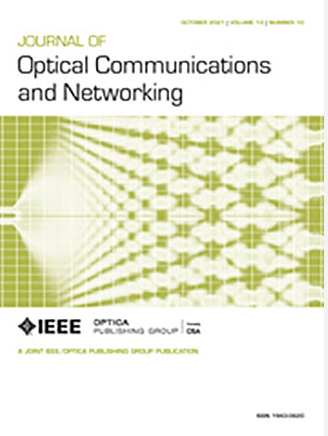具有专用激活波长的hs - pon的节能带宽和波长分配
IF 4.3
2区 计算机科学
Q1 COMPUTER SCIENCE, HARDWARE & ARCHITECTURE
引用次数: 0
摘要
在高速无源光网络(hs - pon)中,引入了上游专用激活波长(DAW)来消除周期性地为光网络单元(ONU)激活创建安静窗口(即时隙)所造成的延迟,从而支持新兴的时间敏感业务。对于DAW,只保留部分带宽用于ONU激活,剩余带宽仍可用于传输非时间敏感业务的数据帧。但是,现有的针对pon的单波长动态带宽分配机制无法支持工作波长和激活波长的协同带宽调度。此外,尽管通过DAW传输数据帧可以在延迟和吞吐量方面提高性能,但它带来了较高的能耗,特别是对于在onu中执行的光数字信号处理功能。本文针对上述问题,对现有的带daw的hs - pon调度协议进行了改进,实现了两个波长的带宽统一调度,并在此基础上进一步分析了最大上行时延。此外,我们还提出了一种节能的带宽和波长分配方案,该方案可以在满足业务延迟需求的同时减少工作波长的数量。仿真结果表明,该方案在不影响延迟约束的情况下,在节能方面优于基准测试,能够很好地满足业务的多样化需求。本文章由计算机程序翻译,如有差异,请以英文原文为准。
Energy-efficient bandwidth and wavelength allocation in HS-PONs with a dedicated activation wavelength
In higher-speed passive optical networks (HS-PONs), an upstream dedicated activation wavelength (DAW) is introduced to eliminate the latency caused by periodically creating quiet windows (i.e., time slots) for optical network unit (ONU) activation, thus supporting emerging time-sensitive services. As for the DAW, only part of the bandwidth is reserved for ONU activation, and the remaining bandwidth can still be used to transmit data frames of non-time-sensitive services. However, the existing dynamic bandwidth allocation mechanism tailored for PONs with a single wavelength cannot support cooperative bandwidth scheduling of working and activation wavelengths. In addition, even though transmitting data frames by the DAW can improve the performance in terms of latency and throughput, it brings high energy consumption, especially for the optical digital signal processing function being performed in ONUs. In this paper, we address the above problems by enhancing the existing scheduling protocols for HS-PONs with DAWs to enable bandwidth scheduling of two wavelengths in a unified way, based on which the maximum upstream latencies are further analyzed. Furthermore, we also propose an energy-efficient bandwidth and wavelength allocation scheme, in which the number of operating wavelengths can be reduced while meeting the services’ latency requirements. Simulation results show that the proposed scheme outperforms the benchmarks in terms of energy saving, without affecting the latency constraint, thus well satisfying services’ diverse requirements.
求助全文
通过发布文献求助,成功后即可免费获取论文全文。
去求助
来源期刊
CiteScore
9.40
自引率
16.00%
发文量
104
审稿时长
4 months
期刊介绍:
The scope of the Journal includes advances in the state-of-the-art of optical networking science, technology, and engineering. Both theoretical contributions (including new techniques, concepts, analyses, and economic studies) and practical contributions (including optical networking experiments, prototypes, and new applications) are encouraged. Subareas of interest include the architecture and design of optical networks, optical network survivability and security, software-defined optical networking, elastic optical networks, data and control plane advances, network management related innovation, and optical access networks. Enabling technologies and their applications are suitable topics only if the results are shown to directly impact optical networking beyond simple point-to-point networks.

 求助内容:
求助内容: 应助结果提醒方式:
应助结果提醒方式:


